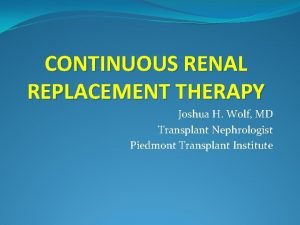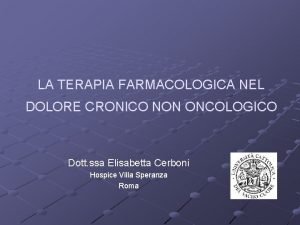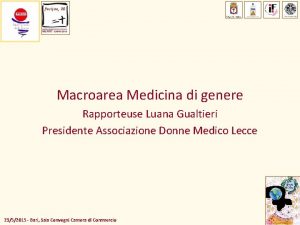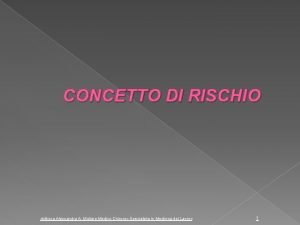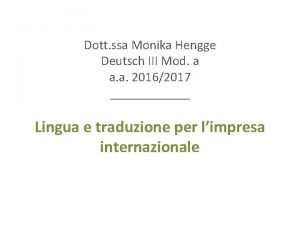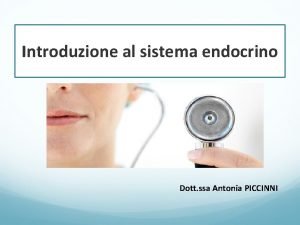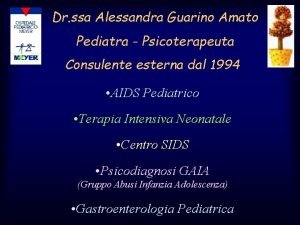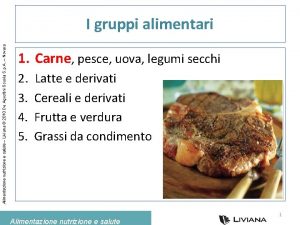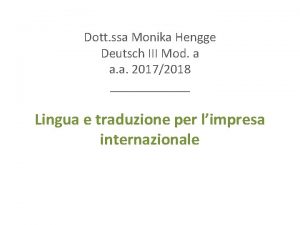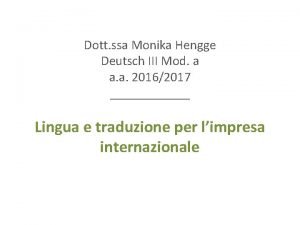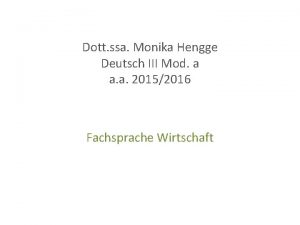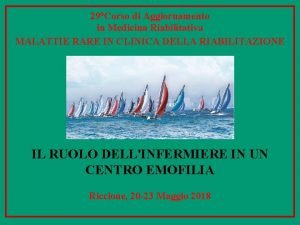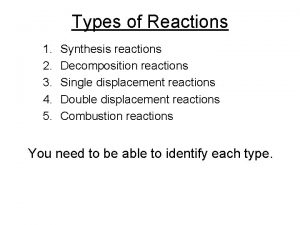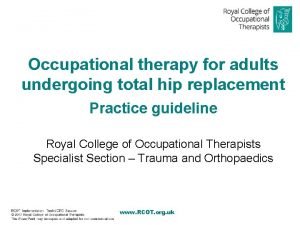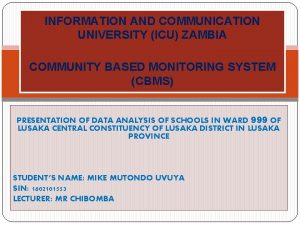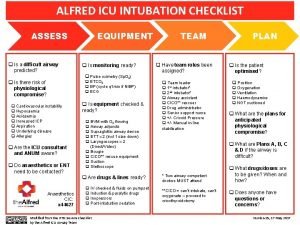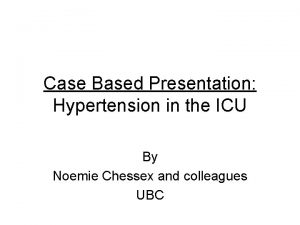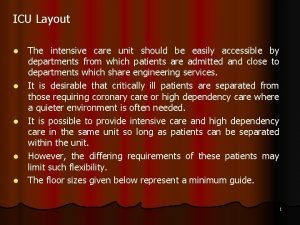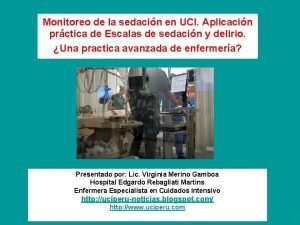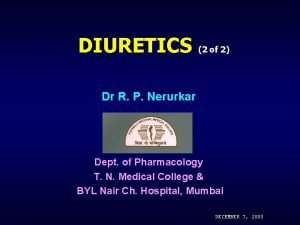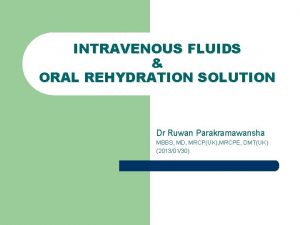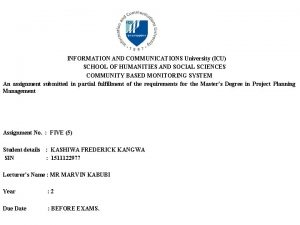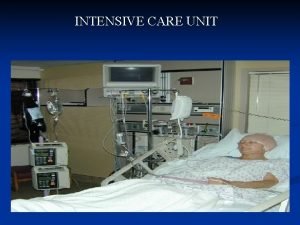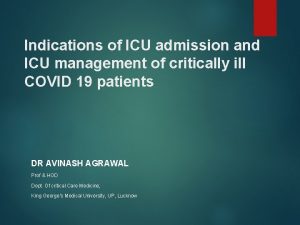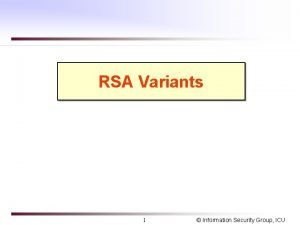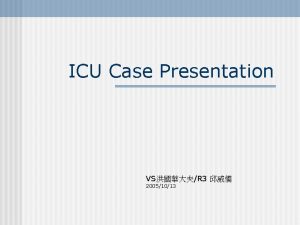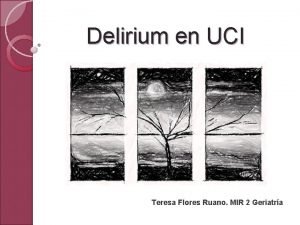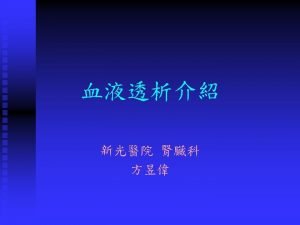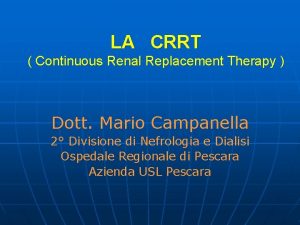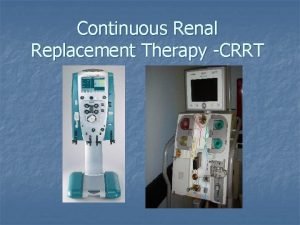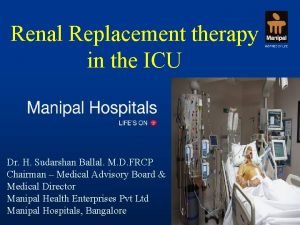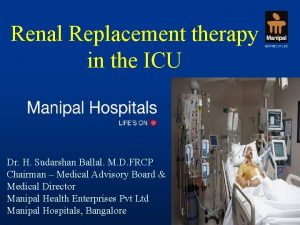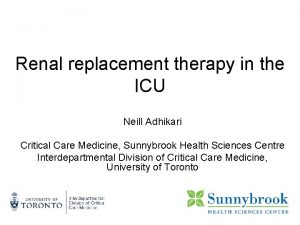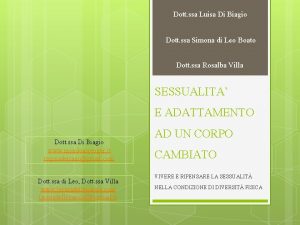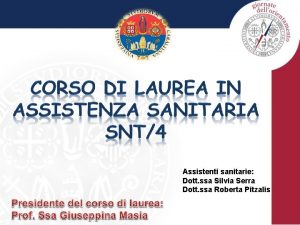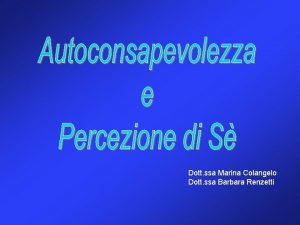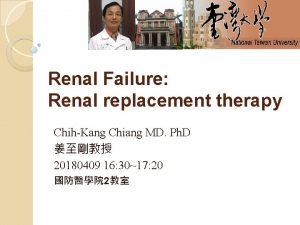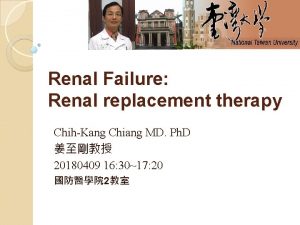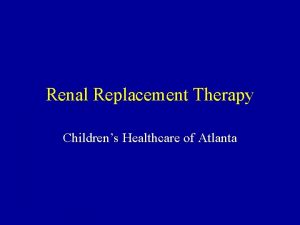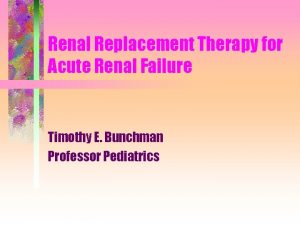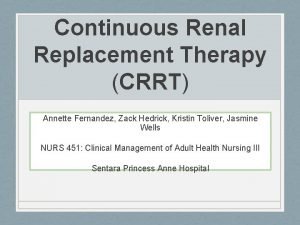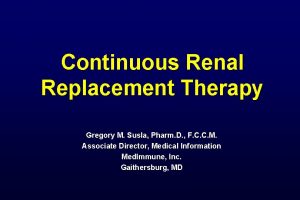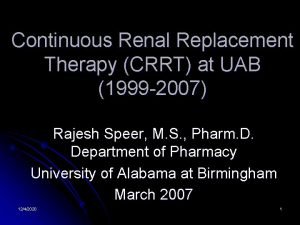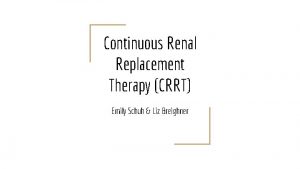CONTINUOUS RENAL REPLACEMENT THERAPY IN ICU Dott ssa












































- Slides: 44

CONTINUOUS RENAL REPLACEMENT THERAPY IN ICU Dott. ssa Maria Vargas Dipartimento di Neuroscienze, Scienze Riproduttive e odontostomatologiche Università degli Studi di Napoli “Federico II” U. O. C Anestesia, Rianimazione e Terapia Antalgica vargas. maria 82@gmail. com

Where are we - too many questions? • • • What therapy should we use? When should we start it? What are we trying to achieve? How much therapy is enough? When do we stop/switch? Can we improve outcomes? Does the literature help us?

Overview • • Impact of Acute Kidney Injury in the ICU Dose-outcome relationships & IRRT v CRRT Mechanisms of solute clearance Therapies in brief – IRRT, CRRT & Hybrid therapies e. g. SLEDD • Solute clearance with IRRT v CRRT v SLEDD • Extracorporeal blood purification in sepsis • Putting it together – making a rational choice

RIFLE and AKIN Classification for AKI

Acute Kidney Injury in the ICU AKIis common: 3 -35%* of admissions AKI is associated with increased mortality “Minor” rises in Cr associated with worse outcome AKI developing after ICU admission (late) is associated with worse outcome than AKI at admission (APACHE underestimates ROD) ROD • AKI requiring RRT occurs in about 4 -5% of ICU admissions and is associated with worst mortality risk ** • • * Brivet, FG et al. Crit Care Med 1996; 24: 192 -198 ** Metnitz, PG et al. Crit Care Med 2002; 30: 2051 -2058

Mortality by AKI Severity (1) Mortality remains unchanged Clermont, G et al. Kidney International 2002; 62: 986 -996

Mortality by AKI Severity (1) Clermont, G et al. Kidney International 2002; 62: 986 -996

RRT for Acute Renal Failure • There is some evidence for a relationship between higher therapy dose and better outcome, at least up to a point • This is true for IHD* and for CVVH** • There is no definitive evidence for superiority of one therapy over another, and wide practice variation exists*** • Accepted indications for RTT vary • No definitive evidence on timing of RRT *Schiffl, H et al. NEJM 2002; 346: 305 -310 ** Ronco, C et al. Lancet 2000; 355: 26 -30 *** Uchino, S. Curr Opin Crit Care 2006; 12: 538 -543

Modalities

Solute Clearance - Diffusion • Small (< 500 d) molecules cleared efficiently • Concentration gradient critical • Gradient achieved by countercurrent flow • Principal clearance mode of dialysis techniques

Solute Clearance – Ultrafiltration & Convection (Haemofiltration) • Water movement “drags” solute across membrane • At high UF rates (> 1 L/hour) enough solute is dragged to produce significant clearance • Convective clearance dehydrates the blood passing through the filter • If filtration fraction > 30% there is high risk of filter clotting* • Also clears larger molecular weight substances (e. g. B 12, TNF, inulin) * In post-dilution haemofiltration

Major Renal Replacement Techniques Intermittent Hybrid Continuous IHD SLEDD CVVH Intermittent haemodialysis IUF Isolated Ultrafiltration Sustained (or slow) low efficiency daily dialysis SLEDD-F Sustained (or slow) low efficiency daily dialysis with filtration Continuous veno-venous haemofiltration CVVHD Continuous veno-venous haemodialysis CVVHDF Continuous veno-venous haemodiafiltration SCUF Slow continuous ultrafiltration

SCUF • • High flux membranes Up to 24 hrs per day Objective VOLUME control Not suitable for solute clearance • Blood flow 50 -200 ml/min • UF rate 2 -8 ml/min

CA/VVH • • • Extended duration up to weeks High flux membranes Mainly convective clearance UF > volume control amount Excess UF replaced Replacement pre- or post-filter • Blood flow 50 -200 ml/min • UF rate 10 -60 ml/min

CA/VVHD • • • Mid/high flux membranes Extended period up to weeks Diffusive solute clearance Countercurrent dialysate UF for volume control • Blood flow 50 -200 ml/min • UF rate 1 -8 ml/min • Dialysate flow 15 -60 ml/min

CVVHDF High flux membranes Extended period up to weeks Diffusive & convective solute clearance • Countercurrent dialysate • UF exceeds volume control • Replacement fluid as required • • Blood flow 50 -200 ml/min UF rate 10 -60 ml/min Dialysate flow 15 -30 ml/min Replacement 10 -30 ml/min

Therapy Dose in IRRT p = 0. 01 p = 0. 001 Schiffl, H et al. NEJM 2002; 346: 305 -310


Therapy Dose in CVVH 45 ml/kg/hr 35 ml/kg/hr 25 ml/kg/hr Ronco, C et al. Lancet 2000; 355: 26 -30


Intermittent Therapies - PRO (Relatively) Inexpensive Flexible timing allows for mobility/transport Rapid correction of fluid overload Rapid removal of dialyzable drugs Rapid correction of acidosis & electrolyte abnormality Minimizes anticoagulant exposure

Intermittent Therapies - CON Hypotension 30 -60% Cerebral oedema Limited therapy duration Renal injury & ischaemia Gut/coronary ischaemia

Continuous Therapies - PRO Haemodynamic stability => ? ? ? better renal recovery Stable and predictable volume control Stable and predictable control of chemistry Stable intracranial pressure Disease modification by cytokine removal (CVVH)?

Continuous Therapies - CON Anticoagulation requirements Higher potential for filter clotting Expense – fluids etc. Immobility & Transport issues Increased bleeding risk High heparin exposure

SLED(D) & SLED(D)-F : Hybrid therapy • • Conventional dialysis equipment Online dialysis fluid preparation Excellent small molecule detoxification Cardiovascular stability as good as CRRT Reduced anticoagulation requirement 11 hrs SLED comparable to 23 hrs CVVH Decreased costs compared to CRRT Phosphate supplementation required Fliser, T & Kielstein JT. Nature Clin Practice Neph 2006; 2: 32 -39 Berbece, AN & Richardson, RMA. Kidney International 2006; 70: 963 -968

Uraemia Control Liao, Z et al. Artificial Organs 2003; 27: 802 -807

Large molecule clearance Liao, Z et al. Artificial Organs 2003; 27: 802 -807

Comparison of IHD and CVVH John, S & Eckardt K-U. Seminars in Dialysis 2006; 19: 455 -464

Timing of initiation of RRT • This is a very important issue and traditionally dialysis is started when standard indications for dialysis like volume overload or solute removal become necessary. • However recent data suggests that early initiation of CRRT improves patient outcome


Outcome with IRRT vs CRRT (1) • • Trial quality low: many non-randomized Therapy dosing variable Illness severity variable or details missing Small numbers Uncontrolled technique, membrane Definitive trial would require 660 patients in each arm! Unvalidated instrument for sensitivity analysis “there is insufficient evidence to establish whether CRRT is associated with improved survival in critically ill patients with ARF when compared with IRRT” Kellum, J et al. Intensive Care Med 2002; 28: 29 -37

Outcome with IRRT vs CRRT (2) • • No mortality difference between therapies No renal recovery difference between therapies Unselected patient populations Majority of studies were unpublished Tonelli, M et al. Am J Kidney Dis 2002; 40: 875 -885

Outcome with IRRT vs CRRT (3) Vinsonneau, S et al. Lancet 2006; 368: 379 -385

Outcome with IRRT vs CRRT (4) Intensive Care Med (2016) 42: 1408– 1417

Proposed Indications for RRT • • • Oliguria < 200 ml/12 hours Anuria < 50 ml/12 hours Hyperkalaemia > 6. 5 mmol/L Severe acidaemia p. H < 7. 0 Uraemia > 30 mmol/L Uraemic complications Dysnatraemias > 155 or < 120 mmol/L Hyper/(hypo)thermia Drug overdose with dialysable drug Lameire, N et al. Lancet 2005; 365: 417 -430

The Ideal Renal Replacement Therapy • • Allows control of intra/extravascular volume Corrects acid-base disturbances Corrects uraemia & effectively clears “toxins” Promotes renal recovery Improves survival Is free of complications Clears drugs effectively (? )

Beyond renal replacement… RRT as blood purification therapy

Extracorporeal Blood Purification Therapy (EBT) Intermittent TPE Therapeutic plasma exchange Continuous HVHF High volume haemofiltration PHVHF Pulsed high volume haemofiltration UHVHF Ultra-high volume haemofiltration CPFA Coupled plasma filtration and adsorption

Peak Concentration Hypothesis • Removes cytokines from blood compartment during pro-inflammatory phase of sepsis • Assumes blood cytokine level needs to fall • Assumes reduced “free” cytokine levels leads to decreased tissue effects and organ failure • Favours therapy such as HVHF, UHVHF, CPFA • But tissue/interstitial cytokine levels unknown Ronco, C & Bellomo, R. Artificial Organs 2003; 27: 792 -801

Threshold Immunomodulation Hypothesis • More dynamic view of cytokine system • Mediators and pro-mediators removed from blood to alter tissue cytokine levels but blood level does not need to fall • ? pro-inflammatory processes halted when cytokines fall to “threshold” level • We don’t know when such a point is reached Honore, PM & Matson, JR. Critical Care Medicine 2004; 32: 896 -897

Mediator Delivery Hypothesis • HVHF with high incoming fluid volumes (3 -6 L/hour) increases lymph flow 20 -40 times • “Drag” of mediators and cytokines with lymph • Pulls cytokines from tissues to blood for removal and tissue levels fall • High fluid exchange is key Di Carlo, JV & Alexander, SR. Int J Artif Organs 2005; 28: 777 -786

High Volume Hemofiltration • May reduce unbound fraction of cytokines • Removes – – endothelin I (causes early pulm hypertension in sepsis) endogenous cannabinoids (vasoplegic in sepsis) myodepressant factor PAI-I so may eventually reduce DIC • Reduces post-sepsis immunoparalysis (CARS) • Reduces inflammatory cell apoptosis • Human trials probably using too low a dose (40 ml/kg/hour vs 100+ ml/kg/hour in animals)

Our prospective and clinical study, conducted on critically ill septic patients with ARF treated using high flux hemofiltration (Qf = 60 m. L/Kg/hr) has shown a progressive increase in transcriptional activity of IL-6 produced by PBMCs

Towards Targeted Therapy? Non-septic ARF Septic ARF Daily IHD? Daily SLEDD? Septic shock HVHF 60 -120 ml/kg/hour for 96 hours CVVHD/F ? dose CVVH @ 35 ml/kg/hour CVVH > 35 ml/kg/hour ? 50 -70 ml/kg/hour PHVHF 60 -120 ml/kg/hour for 6 -8 hours then CVVH > 35 ml/kg/hour Cerebral oedema Honore, PM et al. Int J Artif Organs 2006; 29: 649 -659 EBT
 Res extra commercium
Res extra commercium Teoria do nefron intacto
Teoria do nefron intacto Rrt aeiou
Rrt aeiou Dott.ssa deutsch
Dott.ssa deutsch Chiara giugliano
Chiara giugliano Veronika körner
Veronika körner Dolore pelvico cronico
Dolore pelvico cronico Dott ssa luana gualtieri lecce
Dott ssa luana gualtieri lecce Dott ssa alessandra muliere
Dott ssa alessandra muliere Dott.ssa deutsch
Dott.ssa deutsch Monika hengge
Monika hengge Dott ssa piccinni endocrinologa
Dott ssa piccinni endocrinologa Elena bozzola pediatra
Elena bozzola pediatra Alessandra guarino amato
Alessandra guarino amato Dott.ssa lucia lospalluti
Dott.ssa lucia lospalluti Dott.ssa deutsch
Dott.ssa deutsch Dott.ssa deutsch
Dott.ssa deutsch Dott.ssa deutsch
Dott.ssa deutsch Dott ssa guetta milano
Dott ssa guetta milano Dott ssa benilde cosmi bologna
Dott ssa benilde cosmi bologna Renal corpuscle
Renal corpuscle Combustion equation
Combustion equation Major physiological anions
Major physiological anions Occupational therapy hip replacement interventions
Occupational therapy hip replacement interventions 18004149025
18004149025 Present continuous tense to past continuous tense examples
Present continuous tense to past continuous tense examples Past simple present simple future simple
Past simple present simple future simple Bioness integrated therapy system price
Bioness integrated therapy system price Humanistic therapy aims to
Humanistic therapy aims to Psychodynamic and humanistic therapies have in common
Psychodynamic and humanistic therapies have in common Emphancy
Emphancy Alfred icu
Alfred icu Chatecholamine
Chatecholamine Icu layout and design
Icu layout and design Cam icu
Cam icu Escala de sedacion
Escala de sedacion Mannitol uses
Mannitol uses Types of iv fluid
Types of iv fluid Icu medical b3108
Icu medical b3108 List of lecturers at icu zambia
List of lecturers at icu zambia Icu unit meaning
Icu unit meaning Icu indication
Icu indication Icu security group
Icu security group Icu case presentation
Icu case presentation Cam icu escala
Cam icu escala


